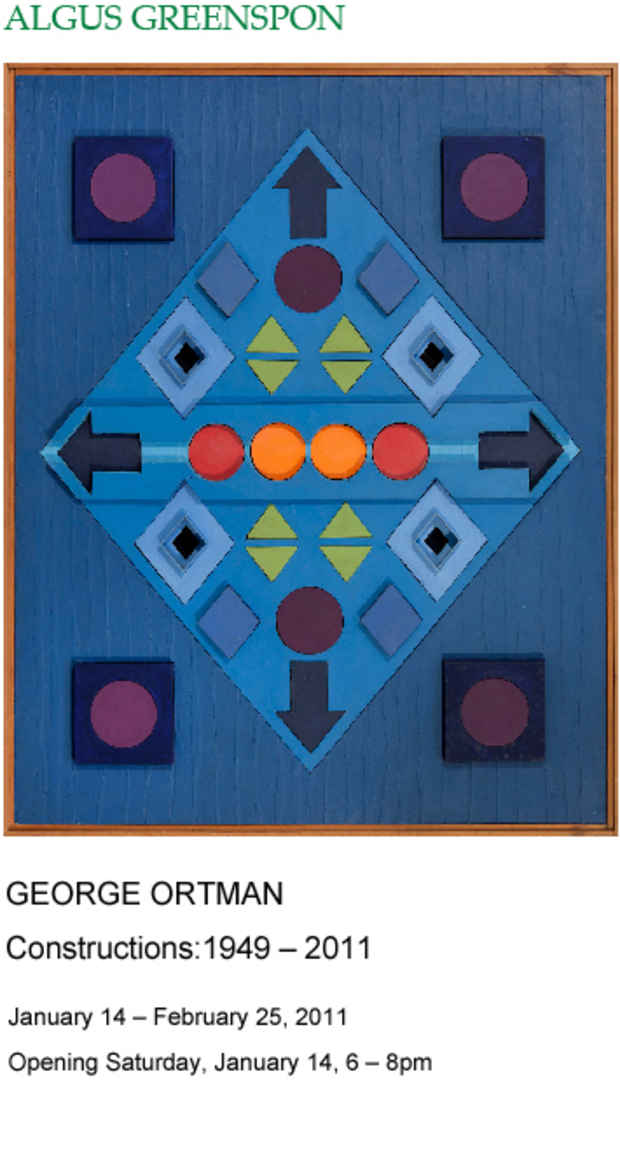George Ortman "Constructions: 1949 – 2011"
Algus Greenspon

This event has ended.
Algus Greenspon presents George Ortman, Constructions: 1949 – 2011, an exhibition surveying 62 years of the artist’s work.
George Ortman’s painted constructions of the 1950s and early 1960s are pioneering works. Their reductive geometry and modular color were widely seen as being at the forefront of young artists move away from abstract expressionism. Writing about the Whitney’s Young America 1960, Hilton Kramer noted that “There is only one artist [in the exhibition] who is equal to a museum showing: that is Mr. George Ortman.” Indeed, Ortman’s work was a particular inspiration to Donald Judd who saw it at the Stable Gallery and repeatedly cited its importance as an antecedent: “[In 1959] George Ortman was doing his best reliefs and had been working along that line for some time. Their worth has never been adequately acknowledged.” (Local History, Arts Yearbook 7, 1964)
In many ways Ortman’s early work forms a missing link between post-war abstraction and the geometric art of the 1960s. As such it fits neatly beside the occult assemblage of Jasper Johns, Robert Rauschenberg and Lee Bontecou in a progression away from abstract expressionism towards something concrete and revelatory. Judd remarks in his seminal essay on the development of the new art of the 1960s, Specific Objects that “The work of Johns and Rauschenberg and assemblage and low-relief generally, Ortman’s reliefs for example, are preliminaries.” (Arts Yearbook 8, 1965) Interestingly, Ortman shares with Johns and Rauschenberg a type of quotidian surrealism, as well as ties to Dada. Ortman’s link to post-war Surrealism originates in his studies at Stanley William Hayter‘s Atelier 17 in New York in 1949. The Dada connection comes via Duchamp, and is evident in the parallels between Ortman’s formal geomancy and chess. As Judd observes: “[Ortman’s constructions] seem to be games or models for some activity and suggest chance, from much through little, controlled and uncontrolled, operating on things both related and unrelated. They are one of the few instances of completely unnaturalistic art. They are concerned with a new area of experience, one which is relevant philosophically as well as emotionally.” (Local History, Arts Yearbook 7, 1964)
The current exhibition starts with Ortman’s first construction, Beginnings (1949), done while in Paris on the GI Bill. Beginnings clearly shows the artist’s assimilation of surrealist influence, taking Cornell’s boxes in a new, abstract/constructivist, direction. Journey of a Young Man (1957 is a sententious work marking Ortman’s transition from surrealism to purely geometric constructions. Like all of Ortman’s art it belies a furtive narrative figuration undergoing an analytical progression towards pure abstraction. Tales of Love (1959), the largest work in Ortman’s breakthrough 1960 exhibition at Stable Gallery, is the apogee of the relentless, reductivist constructions that Judd found so inspirational. Blue Diamond (1960) is Ortman’s most widely reproduced work and was a centerpiece of Toward a New Abstraction, the important 1963 exhibition at the Jewish Museum that defined then emerging post-painterly tendencies. (Here Ortman took equal place alongside Ellswoth Kelly, Frank Stella, Morris Louis and Kenneth Noland.) In the 1970s, as a faculty member at Cranbrook Academy near Detroit, Ortman’s work acquired a riveting elegance. Constructions such as Woodward (1974) and Eye (1977) have the unified formal presence of the best post-war abstraction to come out of New York.
In the late 1980s and 1990s Ortman turned his eye toward Detroit, seeing in the city’s tragic decay themes that were familiar to him from his work at the Tempo Playhouse, the theater he cofounded in 1953 that was the first in America to present plays by Ionesco and Genet. Pilgrim and Jefferson Avenue are two major constructions from this period. Stark in their use of silver, white and graphite, they have a lucid mechanical ferocity bearing interesting comparison to the work of Lee Bontecou. Most recently, fascinated by the geometric possibilities presented by the intersection of four inclined planes, Ortman has been working on an ongoing series of free standing pyramidal forms.
Throughout his career, Ortman has made Imitations based upon classical and modern masterpieces. Included here are drawings for Heartbeat, Ortman’s first (1962) Imitation based on Matisse’s Piano Lesson, and a group of drawings from his study of Paolo Uccello’s Battle of San Romano (1965). These drawings emphasize the figurative and symbolic foundation of Ortman’s art, demonstrating the mechanics of his abstraction and showcasing his extraordinary talent as a draughtsman–an interesting aside for a geometric abstractionist shared by others of his generation such as Ellsworth Kelly.
George Ortman was born in 1926 in Oakland, California. In the early 1950s Ortman showed at the cooperative Tanager Gallery on Tenth Street, then in 1957 and 1960, at the Stable Gallery. Throughout the 1960s Ortman showed at the Howard Wise Gallery. The artist had a one-person exhibition at the Walker Art Center in 1965. In 1970 Ortman left to teach at the Cranbrook Academy in Michigan and stopped exhibiting in New York. The current show is George Ortman’s third exhibition since returning to New York in the 1990s. In 2001 this gallery presented a cycle of paintings from the 1980s based on Georges Seurat’s Models, and in 2006 an exhibition of 4 constructions and new cast sculptures.
Media
Schedule
from January 14, 2012 to March 10, 2012
Opening Reception on 2012-01-14 from 18:00 to 20:00